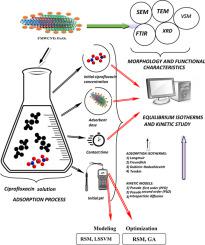Journal of Environmental Chemical Engineering ( IF 7.4 ) Pub Date : 2021-05-14 , DOI: 10.1016/j.jece.2021.105677 Mahmood Yousefi , Mitra Gholami , Vahide Oskoei , Ali Akbar Mohammadi , Mansour Baziar , Ali Esrafili

|
This inquiry focuses on acquiring empirical models to predict ciprofloxacin removal using magnetization of functionalized multi-walled carbon nanotubes (FMWCNTs-Fe3O4) from an aqueous solution. The response surface methodology (RSM) and support vector regression (SVR) as data mining techniques were adopted to develop models. Critical parameter effects comprising pH (3 - 10), adsorbent dose (0.2 – 1 g/L), contact time (5 - 60 min) and ciprofloxacin concentrations (30-100 mg/L) were analysed. The Langmuir, Freundlich, Temkin and Dubinin-Radushkevich isothermal models were utilized to fit the empirical data. FMWCNTs-Fe3O4 prepared by chemical co-precipitation method was loaded by Fe3O4 nanoparticles (using sonication) to synthesize functionalized multi-walled carbon nanotubes to remove ciprofloxacin (CIP). FMWCNTs-Fe3O4 were characterized by fourier transform infrared spectroscopy (FTIR), X-Ray diffraction (XRD), scanning electron microscope (SEM), transmission electron microscope (TEM), vibrating sample magnetometer (VSM) methods. The Langmuir model was utilized to precisely describe the maximum adsorption capacity(qmax) of 107.66 mg/g with R2 =0.998. In this study, the pseudo-second-order model exactly described the adsorption process(R2= 0.99). The results illustrated that the LSSVM (least squares support vector machine) model efficiently predicted the CIP removal percentage with very high accuracy in the training phase (R2=0.975) and the test phase (R2=0.970). Moreover, the highest removal percentages in optimized step were achieved for RSM (pH 5.4, dose 0.78 g/L, time of 24.5 min, and CIP concentrations of 59 mg/L) and GA (genetic algorithm) (pH 4.4, dose 0.74 g/L, time of 42 min, and CIP concentrations of 38 mg/L) techniques by 88 and 99.1%, respectively. The FMCNTs-Fe3O4 efficiency has decreased by 12% even after five used cycles relative to the optimal conditions (regeneration). Therefore, FMWCNTs-Fe3O4 adsorption was considered to be an effective technique for CIP removal in the aqueous environment.
中文翻译:

使用功能化多壁碳纳米管的磁化作用模拟LSSVM和RSM模拟从水溶液中去除环丙沙星的过程:使用GA和RSM技术进行工艺优化
这项研究的重点是获得经验模型,以预测使用功能化多壁碳纳米管(FMWCNTs-Fe 3 O 4)从水溶液中磁化的环丙沙星清除率。采用响应面方法(RSM)和支持向量回归(SVR)作为数据挖掘技术来开发模型。分析了关键参数的影响,包括pH(3-10),吸附剂剂量(0.2-1 g / L),接触时间(5-60 分钟)和环丙沙星浓度(30-100 mg / L)。利用Langmuir,Freundlich,Temkin和Dubinin-Radushkevich等温模型拟合经验数据。通过化学共沉淀法制备的FMWCNTs-Fe 3 O 4负载Fe 3O 4纳米颗粒(使用超声处理)合成功能化的多壁碳纳米管,以去除环丙沙星(CIP)。通过傅里叶变换红外光谱(FTIR),X射线衍射(XRD),扫描电子显微镜(SEM),透射电子显微镜(TEM),振动样品磁力计(VSM)方法对FMWCNTs-Fe 3 O 4进行了表征。用Langmuir模型精确描述了最大吸附容量(q max)为107.66 mg / g,R 2 = 0.998。在这项研究中,伪二级模型准确地描述了吸附过程(R 2= 0.99)。结果表明,LSSVM(最小二乘支持向量机)模型在训练阶段(R 2 = 0.975)和测试阶段(R 2 = 0.970)以非常高的精度有效地预测了CIP去除百分比。此外,对于RSM(pH 5.4,剂量0.78 g / L,时间24.5 分钟,CIP浓度为59 mg / L)和GA(遗传算法)(pH 4.4,剂量0.74 g ),在优化步骤中达到了最高去除率。/ L,42 分钟的时间和38 mg / L的CIP浓度)分别降低了88%和99.1%。FMCNTs-Fe 3 O 4相对于最佳条件(再生),即使经过五个使用周期,效率也降低了12%。因此,FMWCNTs-Fe 3 O 4吸附被认为是在水性环境中去除CIP的有效技术。











































 京公网安备 11010802027423号
京公网安备 11010802027423号